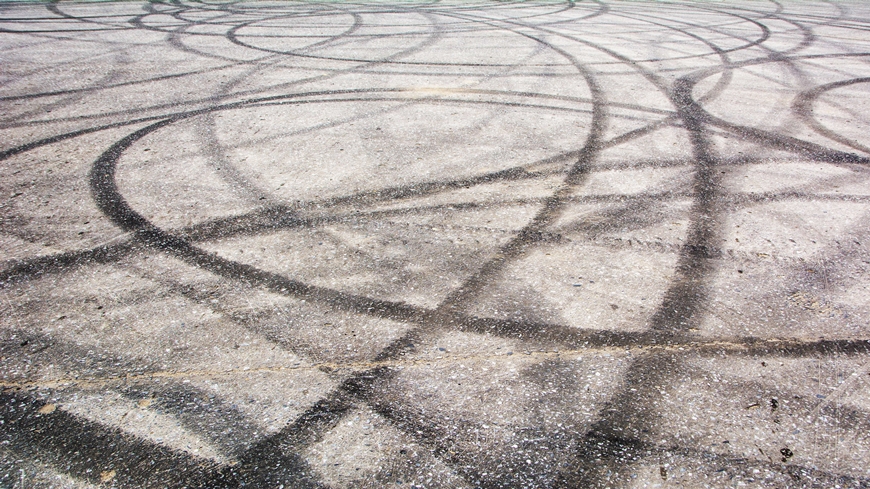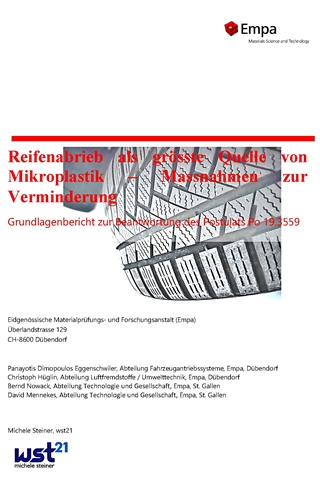Environmental impact with microplastics
Vehicle tires as a source of microplastics
Tire wear of motor vehicles is responsible for a large proportion of microplastics in the environment. Researchers from Empa and the company wst21 have summarized the results of various studies in a recently published basic report in response to postulate Po 19.3559 and presented approaches for reduction.

Tires are the interface between the vehicle and the road. When accelerating, they transfer the power of the engine to the road surface and thus propel the vehicle. When braking, the speed is reduced via the tires. Strong accelerations leave, , black marks on the road - the same happens during emergency braking, whereby the anti-lock braking system (ABS) tries to prevent this as best it can.
However, tire wear is not only generated during these extreme manoeuvres, but also during every "normal" drive; even at constant speed, the tires rub against the road surface, releasing tire material into the environment. The characteristics of the tires and the driving style are the main factors determining wear. A smaller, but not insignificant, contribution is also due to vehicle characteristics and road condition.
How much tire wear is produced and what happens to it?
Tire wear is present in the environment in the form of particles that are usually smaller than a few millimeters and consist of a mixture of tire and road material. The rubber part of tire wear is considered microplastic, i.e. plastic particles smaller than 5 millimeters. In Switzerland, tire wear accounts for an estimated 90 percent of the microplastics released into the environment. Based on existing studies, it can be estimated that an average of around 1.4 kilograms of tire abrasion per inhabitant per year is produced and released into the environment. However, the problem with these studies is that most measurements of tire wear are based on studies from the 1970s. Due to the further development of tires, there is a need for updated data.
Around a quarter of tire abrasion is retained in road runoff treatment plants (SABAs), road shoulders, sludge collectors or municipal wastewater treatment plants. An estimated 16 to 39 percent ends up in water streams and 36 to 57 percent in the roadside and soil. Depending on the rubber compound of the tires, the particles are more or less toxic. Additives such as ozone inhibitors have proven to be particularly harmful to aquatic life. It is not possible to conclusively assess the effects and risks for humans and the environment, as there are no detailed studies on this either.
How can tire wear and its effects be reduced?
There are numerous ways to reduce tire wear, ranging from measures on the tires to those on the vehicle and driving behavior to general aspects of mobility. One easy-to-implement measure is to optimize the rubber compound of the tires to minimize tire wear. Once tire wear has been released, it should at least be better retained by the road drainage system. However, it is not only the amount of tire wear that needs to be reduced in order to reduce environmental pollution, but also its toxicity. Solutions can be tire compounds that are optimized in terms of lowest possible toxicity.
Lower vehicle weight, correct tire pressure and correctly adjusted axle geometry are vehicle-specific measures to reduce tire wear. There are also ideas in order to capture tire wear on the vehicle and thus prevent it from entering the environment. However, these ideas have not yet gone beyond concept studies and there are no serial applications yet..
It has been proven that driving as evenly as possible has the greatest effect on reducing tire wear. To achieve this, speed harmonization and hazard warning systems can be used on national roads with higher traffic volumes.
In the case of national highways, measures relating to the drainage system (e.g. the replacement of direct discharge or oil separators with state-of-the-art SABAs or infiltration in the road shoulder) are already being implemented as part of the maintenance planning. However, the adaption of road drainage is more difficult to implement in urban areas than in rural areas, as surfaces required for SABAs are generally lacking.
International standardization necessary
It is also very important to develop a standardized and internationally recognized method for quantifying tire wear on cars and trucks. This is the only way to reliably compare the results of different studies and define limit values. Discussions on this topic are underway within the UNECE ("United Nations Economic Commission for Europe"). A test procedure and limit values at EU level can be expected in the next five years. A standardized measurement procedure should give more weight to the problem of tire abrasion in the development of tires.
Dr. Panayotis Dimopoulos Eggenschwiler
Automotive Powertrain Technologies
Phone +41 58 765 43 37
Rémy Nideröst
Communications
Phone +41 58 765 45 98
redaktion@empa.ch
Empa and wst21 report in response to postulate Po 19.3559: The report can be downloaded here (only available in German).

-
Share






